

Futuro. Futuro, or Futuro House, is a round, prefabricated house designed by Matti Suuronen, of which fewer than 100 were built during the late 1960s and early 1970s.
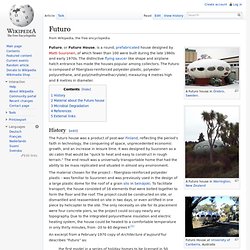
The distinctive flying saucer like shape and airplane hatch entrance has made the houses popular among collectors. The Futuro is composed of fiberglass-reinforced polyester plastic, polyester-polyurethane, and poly(methylmethacrylate), measuring 4 metres high and 8 metres in diameter. History[edit] The Futuro house was a product of post-war Finland, reflecting the period's faith in technology, the conquering of space, unprecedented economic growth, and an increase in leisure time. It was designed by Suuronen as a ski cabin that would be “quick to heat and easy to construct in rough terrain.” The material chosen for the project – fiberglass-reinforced polyester plastic - was familiar to Suuronen and was previously used in the design of a large plastic dome for the roof of a grain silo in Seinäjoki. Dymaxion house. The Dymaxion House was developed by inventor and architect Buckminster Fuller to address several perceived shortcomings with existing homebuilding techniques.

Icosahedron. In geometry, an icosahedron (/ˌaɪkɵsəˈhiːdrən/ or /aɪˌkɒsəˈhiːdrən/) is a polyhedron with 20 triangular faces, 30 edges and 12 vertices.
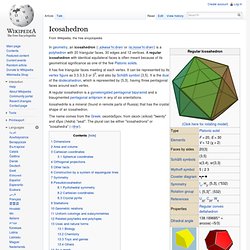
A regular icosahedron with identical equilateral faces is often meant because of its geometrical significance as one of the five Platonic solids. It has five triangular faces meeting at each vertex. It can be represented by its vertex figure as 3.3.3.3.3 or 35, and also by Schläfli symbol {3,5}. It is the dual of the dodecahedron, which is represented by {5,3}, having three pentagonal faces around each vertex. Chlorella. Futurist. Futurists or futurologists are scientists and social scientists whose specialty is futurology, or the attempt to systematically explore predictions and possibilities about the future and how they can emerge from the present, whether that of human society in particular or of life on Earth in general.
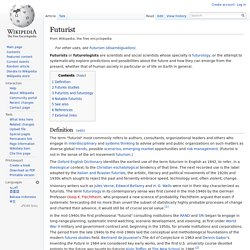
Definition[edit] The term "futurist" most commonly refers to authors, consultants, organizational leaders and others who engage in interdisciplinary and systems thinking to advise private and public organizations on such matters as diverse global trends, possible scenarios, emerging market opportunities and risk management. (Futurist is not in the sense of the art movement futurism.) Visionary writers such as Jules Verne, Edward Bellamy and H. G. Futures studies[edit] "Futures studies"—sometimes referred to as futurology, futures research, and foresight—can be summarized as being concerned with "three P's and a W", i.e. Futurists and futurology[edit] Notable futurists[edit] See also[edit] Unsupported Browser - Inkling Habitat. Unsupported Browser. Our Future EarthOur Future Earth. Timeline: Earth's Precarious Future.
Our planet and its inhabitants - including we humans - are in a precarious position as we approach Earth Day, April 22.
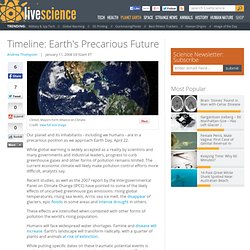
While global warming is widely accepted as a reality by scientists and many governments and industrial leaders, progress to curb greenhouse gases and other forms of pollution remains limited. The current economic climate will likely make pollution control efforts more difficult, analysts say. Recent studies, as well as the 2007 report by the Intergovernmental Panel on Climate Change (IPCC) have pointed to some of the likely effects of uncurbed greenhouse gas emissions: rising global temperatures, rising sea levels, Arctic sea ice melt, the disappear of glaciers, epic floods in some areas and intense drought in others.
These effects are intensified when combined with other forms of pollution the world's rising population. Humans will face widespread water shortages. Arctic sea ice hits its second lowest summer ice extent on record (the lowest extent was in 2007). The U.S. New Earth found. Its sun's name is Tau Ceti, visible to the naked eye and the planet is one of five in its orbit, thought to have the conditions to support life.
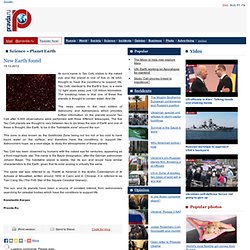
Tau Ceti, identical to the Earth's Sun, is a mere 12 light years away, just 120 trillion kilometres. The breaking news is that one of these five planets is thought to contain water. And life. The news comes in the next edition of Astronomy and Astrophysics which provides further information on the planets around Tau Ceti after 6,000 observations were performed with three different telescopes. The five Tau Ceti planets are thought to vary between two to six times the size of Earth and one of these is thought, like Earth, to be in the "habitable zone" around the sun. This zone is also known as the Goldilocks Zone being not too hot or too cold to have liquid water on the surface, and therefore have the conditions to support life. MARS ONE. Future Earth. Technology - Tomorrow’s world: A guide to the next 150 years. Tomorrow's world: A guide to the next 150 years.
BIOS-3. BIOS-3 is a closed ecosystem at the Institute of Biophysics in Krasnoyarsk, Russia.
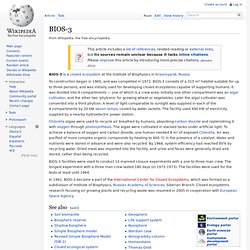
Its construction began in 1965, and was completed in 1972. BIOS-3 consists of a 315 m³ habitat suitable for up to three persons, and was initially used for developing closed ecosystems capable of supporting humans. It was divided into 4 compartments — one of which is a crew area. Initially one other compartment was an algal cultivator, and the other two 'phytrons' for growing wheat or vegetables. Later the algal cultivator was converted into a third phytron. Chlorella algae were used to recycle air breathed by humans, absorbing carbon dioxide and replenishing it with oxygen through photosynthesis. BIOS-3 facilities were used to conduct 10 manned closure experiments with a one to three man crew.